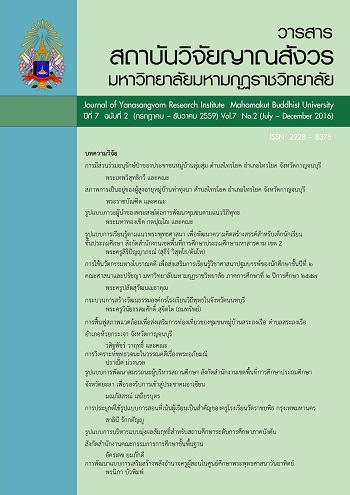The community development by Dhamma of Buddhism : A Case study of Sub-District Administrative Organization In Pathumthani Province
Main Article Content
Abstract
The objectives of this thesis were 1) to study the development community of sub-district administrative organization member, 2) to study the development community with the Buddhist principle of sub-district administrative organization member, and 3) to study the suggestions and approach to the problem of the development community with the Buddhist principle of sub-district administrative organization. Research instruments were questionnaires and to interview. The sampling have two groups were that the first group was the 278 persons from 992 members of sub-district administrative organization in Pathumthani province by open table of Krejcie and Morgan and made simple random samplings. The second group was 5 presidents sub-district administrative organization in Pathumthani province. Statistics analysis data by descriptive statistics were frequency, percentage, mean and standard deviation. Inferential statistics used Pearson’s product moment correlation and analyzed by computing. The results of research were found as follows : The opinion of sub-district administrative organization member in Pathumthani province toward the development community overall parts were at middle level. The evaluation was at more level. Next, the planning/project, the implementation of the plans and project, the providing education to community were at middle level. And the education of community was at middle level respectively. To take the Buddhist principle was karavasadhamma the development community of sub-district administrative organization member overall parts were at space-time level. When considered each part found that the most average part was the Sajja. Next part was the Kanti and Jaca. And the least average part was Thama. The comparison result found that the All predictors were correlated to take the Buddhist principle was karavasadhamma the development community significant statistically. And Guidelines To take the Buddhist principle was karavasadhamma the development community of sub-district administrative organization member were 1) Sajja was create awareness of ethical, moral, moral duty. 2) Thama was human resources development by promoting active learning, according to authorities. 3) Kanti was using the members together, or people around to talk, public hearing and hearing problems. 4) Jaca was to encourage members to use the practice to sacrifice social assistance
Article Details
References
พระเมธีธรรมาภรณ์ (ประยูร ธมฺมจิตฺโต). การปกครองคณะสงฆ์ไทย. กรุงเทพมหานคร : บริษัทสหธรรมิก จำกัด, 2539.
สำนักงานคณะกรรมการแผนพัฒนาเศรษฐกิจและสังคมแห่งชาติ. แผนพัฒนาเศรษฐกิจและสังคมแห่งชาติ ฉบับที่ 11 (พ.ศ.2555-2559). กรุงเทพมหานคร : สำนักงานคณะกรรมการแผนพัฒนาเศรษฐกิจและสังคมแห่งชาติ, 2554.
สำนักงานจังหวัดปทุมธานี. แผนพัฒนาจังหวัด จังหวัดปทุมธานี พ.ศ. 2553-2556. ปทุมธานี : สำนักงานจังหวัดปทุมธานี, 2553. http://www.thairath.co.th


